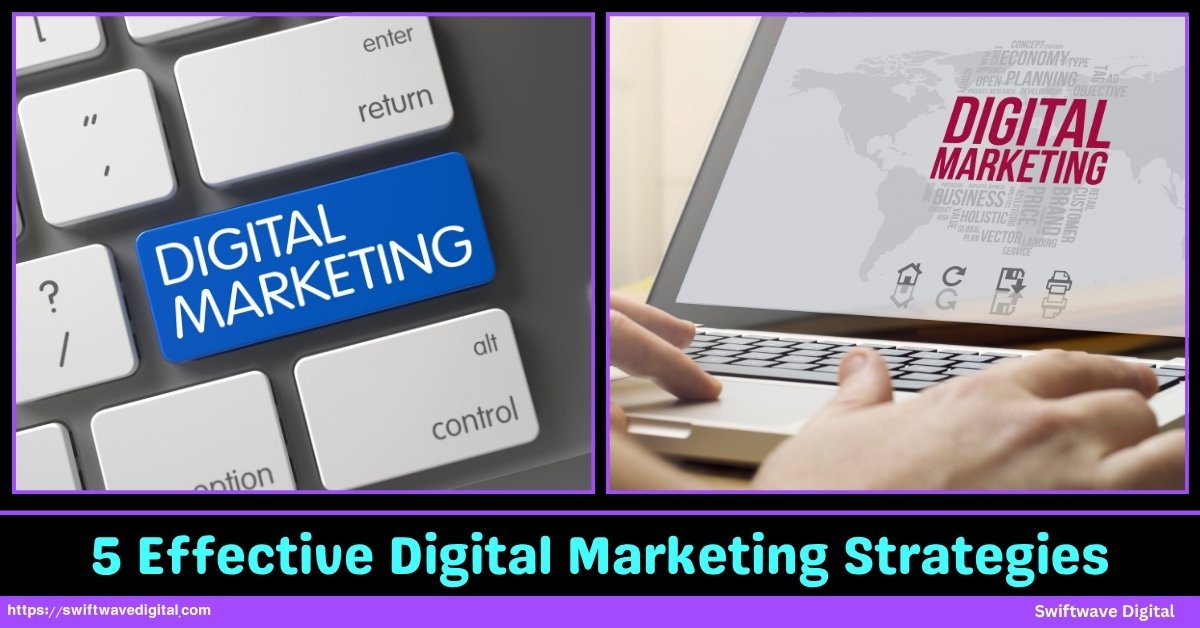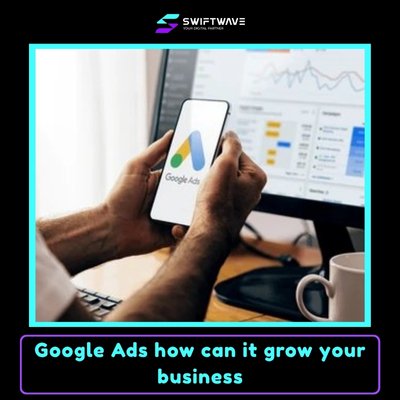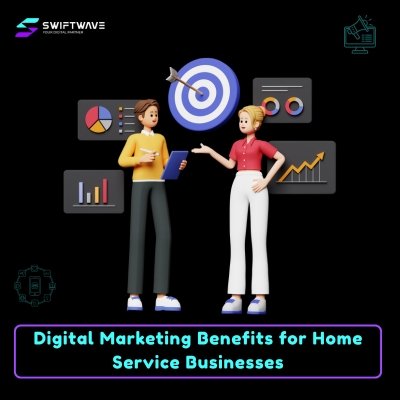Digital Marketing Strategies are no longer optional they’re the backbone of every successful business today. Whether you’re running a startup or scaling an established brand, your ability to attract, engage, and convert online audiences determines your growth.
The digital space is crowded, attention spans are shrinking, and consumers expect instant value. That’s why businesses that thrive aren’t the ones doing “more” marketing they’re the ones doing it smarter.
From precision-targeted ad campaigns to SEO that captures real buyer intent, from content that educates to emails that convert every move in your digital marketing plan must be intentional, measurable, and data-driven.
In 2025, guesswork is dead; execution and optimization rule the game.
5 Effective Digital Marketing Strategies
In this guide, we will explain five effective Digital Marketing Strategies that actually drive sales, build trust, and grow your business in the real world.

1. Paid Advertising with Precision
Paid advertising is the fastest and most controlled way to reach potential buyers online. It gives you the ability to target specific audiences, control budgets, and scale quickly.
But most businesses waste money on ads because they run campaigns without a strategy. Effective paid advertising starts with understanding your audience and crafting a funnel that matches their intent.
Instead of running one general ad, segment your campaigns by awareness, interest, and conversion.
The first step is audience targeting. Define who you want to reach not just by demographics, but by intent and behavior. For example, use data such as pages visited, search terms used, or products viewed to refine your targeting.
Platforms like Meta and Google Ads allow this level of accuracy. Always focus on people who are most likely to take action, not just anyone who fits a broad category.
Next, focus on ad creative and message clarity. Your ad must answer one question instantly: “What’s in it for me?” Use short, benefit-driven headlines and clear visuals. People don’t buy ads; they buy outcomes.
Instead of promoting “our services,” highlight the transformation — like “Increase your online sales in 30 days.” Keep your offer simple and make your call-to-action (CTA) specific, such as “Book a Free Consultation” or “Start Your Campaign Today.”
Finally, optimize continuously. Run A/B tests on ad copies, visuals, and CTAs. Analyze click-through rates (CTR), conversion rates, and return on ad spend (ROAS).
Kill underperforming ads quickly and double down on the ones converting. Paid advertising only works when it’s treated as a process, not a one-time event. The goal is not just to get clicks — it’s to get profitable conversions.
2. Content That Converts
Content is what drives attention, builds trust, and turns awareness into action. But most brands still create content for the sake of posting. The real power of content marketing lies in delivering value that positions your business as a trusted authority.
Every piece of content should have a purpose to educate, solve a problem, or drive the reader toward a clear next step.
Start by identifying the core pain points of your audience. What are they trying to solve? What are they confused about? When your content directly addresses those needs, it naturally attracts engagement.
Blogs, videos, and social posts should answer questions your ideal customer is already asking online. Use keywords strategically, but write in a way that’s human, not robotic.
Use a value-first approach. Teach something useful before you sell. For example, share quick guides, comparisons, or how-to tips related to your industry.
The more value your audience gets from your free content, the more they’ll trust your paid solutions. This principle applies across all formats blogs, short videos, or even LinkedIn posts.
Always include a soft call-to-action in your content. After delivering value, invite your reader to take the next step: download a guide, sign up for a newsletter, or schedule a free consultation.
The key is to move them gently through your marketing funnel. Content that sells isn’t aggressive it’s persuasive through relevance.
Finally, measure what works. Track engagement, click-throughs, and leads generated from each content piece.
Repurpose high-performing topics into other formats a blog can become a video, a social post, or an email. The more consistent you are, the more authority you build.
3. Email Marketing Power
Email marketing remains one of the most powerful and underused tools in digital marketing. It’s personal, measurable, and cost-effective.
Despite the rise of social media, email still delivers the highest ROI an average of $36 for every $1 spent. The reason? You own your list, and your message goes directly to the customer’s inbox without algorithm interference.
The foundation of effective email marketing is segmentation. Sending the same message to every subscriber doesn’t work. Divide your audience based on their behavior new leads, active customers, and inactive users.
Then, tailor your content to each group. Welcome emails introduce your brand; promotional emails offer value; re-engagement emails bring back lost leads.
Next, focus on clarity and simplicity in your email copy. Keep subject lines short and direct the goal is to get opened. In the email body, write like you’re talking to one person.
Use simple language, short sentences, and one clear call-to-action. Instead of stuffing multiple offers, give readers one reason to click.
Automation is key to scaling results. Set up automated sequences for new subscribers, cart abandoners, and repeat customers. These workflows save time and ensure consistent communication.
Regularly review performance metrics such as open rates, CTR, and conversion rates. If engagement drops, adjust subject lines, send times, or frequency.
Email is not about volume; it’s about relevance. The more targeted and timely your messages are, the higher your conversions. When used right, email marketing keeps your brand in front of customers and continuously drives repeat sales.
4. SEO with Intent
Search Engine Optimization (SEO) is essential for long-term digital growth. Unlike ads, SEO brings in organic traffic without paying for every click. However, ranking high is not enough; you need to rank for keywords that convert. This is where intent-based SEO comes in.
Focus on commercial and transactional keywords phrases people use when they’re ready to take action. Examples include “digital marketing agency near me,” “best SEO service for small business,” or “buy running shoes online.” These searches signal buying intent, not just curiosity.
Your website content should be structured around these keywords naturally. Write clear titles, meta descriptions, and headers that align with user intent.
Add relevant internal links to guide visitors toward your main service or product pages. Don’t over-optimize with keyword stuffing focus on clarity and helpfulness.
Local SEO is another important factor. If you serve a specific area, claim and optimize your Google Business Profile. Add accurate business information, upload photos, respond to reviews, and post regular updates.
Businesses that do this see significantly more visibility and clicks from local searches.
Consistency is critical. SEO isn’t something you do once it’s an ongoing process. Regularly update existing pages, add fresh content, and monitor analytics.
Over time, this steady effort builds authority, traffic, and leads. The goal is not to chase rankings but to attract people who are already searching for what you offer.
5. Social Media that Builds Demand
Social media is more than a branding tool it’s a demand-generation engine when used strategically. The mistake most businesses make is treating it like a popularity contest.
Followers and likes mean nothing without engagement or sales impact. The purpose of social media marketing is to stay top of mind, build relationships, and guide people toward your offer.
The foundation is consistent, value-based posting. Focus on content that educates, informs, and entertains your audience. Use a simple rule: 40% value, 30% proof, 20% offer, 10% personal or behind-the-scenes. This keeps your feed balanced and authentic.
Video content now dominates all platforms. Short-form videos on TikTok, Instagram Reels, and YouTube Shorts get the highest reach and retention. Use videos to explain solutions, share customer experiences, or demonstrate results. Keep them short, direct, and visually appealing.
Engagement is what turns followers into customers. Reply to comments, answer messages, and participate in discussions. People buy from brands they feel connected to.
When you engage genuinely, your audience sees you as approachable, not just promotional.
Finally, combine organic and paid strategies. Boost high-performing posts to reach a larger audience. This hybrid approach allows you to test messages organically and then amplify what works using ads. Social media should not be random — it should be part of your conversion path that leads followers to take action.
6. Measure What Matters
Without tracking performance, you’re just guessing. Every digital marketing effort must be supported by measurable data. Numbers reveal what’s working and what needs improvement. The key is to focus on metrics that affect revenue, not vanity statistics.
Start with click-through rate (CTR) — it shows whether people are responding to your message. Then look at conversion rate, which tells you if those clicks are turning into leads or sales.
Track customer acquisition cost (CAC) to ensure your campaigns remain profitable. Finally, measure return on ad spend (ROAS) to understand your real ROI.
Use tools like Google Analytics, Meta Ads Manager, and CRM dashboards to collect and analyze data. Review your results weekly or monthly and make decisions based on evidence, not assumptions.
If a campaign isn’t converting, change one variable at a time — ad copy, creative, or audience. Small adjustments often lead to significant improvements.
Data-driven marketing helps you allocate your budget more efficiently. When you know exactly what generates results, you stop wasting money on guesswork. Always let metrics guide your next move.
7. Bring It Together
Every digital marketing strategy works best when it’s part of a connected system. Paid ads attract instant attention, SEO builds long-term visibility, content educates, social media engages, and email converts. When all five work together, they create a loop of consistent growth.
For example, an ad can bring a visitor to your website, your content can educate them, your email can follow up, and your SEO ensures new visitors keep coming. This cycle keeps your pipeline full at all times.
Avoid working in silos. Align your messaging, tone, and design across all channels. Make sure your brand voice is consistent — what people see on your website should match what they experience on your social media or in your emails.
The goal is simple: create a seamless customer journey where every touchpoint reinforces your credibility and value. That’s how digital marketing turns from random activity into a structured growth system.
8. Why Most Businesses Fail
Most businesses fail at digital marketing not because the tools don’t work, but because their execution is inconsistent. They post for a month and stop, run one ad and quit, or create content without a clear plan. Success comes from patience, testing, and continuous improvement.
Another common mistake is chasing trends instead of mastering fundamentals. A new platform or feature won’t save a poor strategy. Focus on understanding your audience, crafting clear messages, and tracking results. Once the foundation is strong, scaling becomes easy.
Businesses also fail when they ignore data. Emotion and opinions can’t compete with numbers. Decisions should always come from analytics — what’s actually performing, not what feels good.
Finally, success in digital marketing requires a long-term mindset. Quick wins are possible, but lasting growth comes from consistency. The brands that keep showing up, optimizing, and learning are the ones that win over time.
Conclusion
Digital marketing isn’t about doing everything it’s about doing the right things consistently and strategically. Success today depends on precision, not luck.
When you align paid ads, SEO, content, social media, and email marketing into one connected system, your business doesn’t just attract attention it builds authority, trust, and predictable growth.
The key is focus. Each strategy supports the other: ads bring leads, content nurtures them, SEO brings steady traffic, emails convert, and social media keeps your brand alive in the customer’s mind. Together, they form a cycle that feeds continuous momentum.
Avoid shortcuts, ignore noise, and commit to improving one metric at a time. Track your performance, refine your message, and stay consistent that’s where the real power lies.
The businesses winning in 2025 aren’t the ones with the biggest budgets — they’re the ones with the clearest systems.
Master these five digital marketing strategies, and you won’t just grow your reach — you’ll grow real revenue, real trust, and real results.



